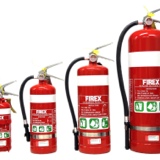Information
-
Document No.
-
Audit Title
-
Client / Site
-
Conducted on
-
Prepared by
-
Location
-
Personnel
-
What time/date was the survey conducted?
-
Is the building fitted with an Automatic Fire Sprinkler System?
Class A Fire Protection
-
What is the Class A risk classification?
-
Light - Premises such as domestic/residential, offices, schoolrooms, relocatable buildings, churches and assembly halls. Ordinary - Mercantile storage and display areas, showrooms and workshops. High - Woodworking areas, warehouses with high piled storage in excess of 4.5m and foam plastics processing.
-
Are their sufficient ABE, Water or Foam extinguishers with suitable rating for Class A Fire Risk? (Consider rating and floor area size)
-
is there a sufficiently rated extinguisher for Class A Fires within 15 meters of any point in the building?
Class B Fire Protection
-
What is the Class B risk classification?
-
Light - Areas where flammable liquids are stored in containers not exceeding 5 L in capacity and the total quantity in any one fire compartment does not exceed 25 L. Ordinary Hazard - Areas where flammable liquids are stored in open-top containers in which the surface area of the liquid does not exceed 2m squared, or in container storage not exceeding a total of 250 L in containers not each greater than 20 L. High - Flammable liquids stored in open-top containers where the exposed surface area of the liquid exceeds 2 M squared or in container storage exceeding a total of 250L.
-
Are their sufficient ABE or Foam extinguishers with suitable rating for Class B Fire Risk? (Consider rating, floor area size and travel distance.)
Supplementary Risks
-
Is there a Class F risk? If yes is there a sufficiently sized extinguisher installed between 2-20 meters from the risk?
-
Is there a risk of a Human Torch Fire? (If so are Fire Blankets installed?)
-
Does the building have a Significant Switchboard?
-
A significant switchboard is located in an exit, neither constructed/installed in accordance with AS 3000-1970, an emergency service switchboard, connected to 3 phase power or vertically aligned and servicing a floor in a building of 2 or more storeys.
-
If a significant switchboard is installed is the nearest extinguisher a 5KG C02 OR an ABE extinguisher with a minimum rating of 1A:E and a hose?
-
Does the site have employer owned vehicles? If yes are extinguishers installed in those vehicles? (Note any extinguisher installed in a commercial vehicle must be fitted with a hose and have a rating in accordance with AS 2444.)
-
Are extinguishers installed in an aggressive environment and if so are they protected from that environment?
-
Examples of an aggressive environment include where the extinguisher is exposed to sun, UV radiation, wind, rain or salt spray. It can also include corrosive environments, dusty/moisture laden atmospheres, continuous or intense vibrations or extremes of tempreture.
-
If there are multiple ares of high risk for Class A and/or Class B, would a Fire Point be appropriate?
-
If there are multiple areas of high risk for Class A, Class B or Class E, would a wheeled or mobile extinguisher
Signage
-
Do all extinguishers have location signage? Is this signage visible from 20 m in ALL directions of approach?
-
Where applicable do all extinguishers have Right Angled Signage?
-
Do all extinguishers have identification signage?
-
Are warning signs required for miss-use of hose reels?
Sales Opportunities
-
Does the site have a need for a Fire Blanket?
-
A Fire Blanket is recommended where a Class F Risk is present, a stove top is installed or there is a risk of a human torch fire.
-
If Fire Blankets are installed are they a sufficient size and correctly sign posted?
-
Are Fire Blankets in good condition, container secure to wall and the blanket not frayed, damaged or aged?
-
Would larger location signs be appropriate?
-
If equipment installed on this site is in an aggressive environment is in installed in a cabinet or UV cover?
-
For Hydrant Systems are the following installed/in place: Blanking Caps, Chains on hydrants which can be vandalized, block plans (sites with booster), is the booster isolation valve secured, signage if required, BIC washer in good condition, confirm overhaul date is not exceeded.
-
For Fire Hose Reels are the following installed/in place: nozzle fitted into interlock (post 1989 FHR only), signage (where required), not obstructed, not leaking from nozzle, not leaking from centre hub, cover or cabinet if installed in an aggressive environment, operating label legible.
Other
-
What other Fire Equipment is installed?
-
Fire Detection/Alarm System, Sprinklers, Exit/Emergency Lights, Fire Doors, Evacuation Plans, Fire Wardens etc
-
Confirm by signing below that a flow test has been conducted on hydrants.
-
Confirm the contents of this survey are accurate and the service was conducted in accordance with AS 1851.














